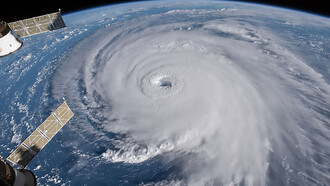It was 1978 and I was finally becoming a responsible student in my agronomy studies. At that time, I was 100% involved with insects and was fully working on a project coordinated by my tutor, Francisco Fernández Yépez (1923-1986). I used to go out to collect insects (not as often as I wanted) in either Rancho Grande, in the Henri Pittier National Park, in Aragua State, or Guatopo National Park, in Miranda and Guárico States, mainly. That same year, ”A Guide to the Birds of Venezuela” by William H. Phelps Jr. (1902-1988) and Rodolphe Meyer de Schauensee (1901-1984) appeared in the libraries and bookstores. A friend suggested that I buy it.
After seeing me in Rancho Grande with the book and my cheap binoculars, another friend suggested that to comprehend the birds of the place, I should not limit myself to birdwatching, but try to understand them by studying their behavior and ecology. He recommended that I obtain ”The Birds of the Henri Pittier National Park (Rancho Grande) and their ecological functions" a paper that appeared in the Bulletin of the Venezuelan Society of Natural Sciences (SVCN) under the authorship of Ernst Schäfer (1910-1992) and William H. Phelps (1875-1965). Schäfer had founded the Biological Station where we were, but this Phelps, ... would it be the same Phelps from the bird guide book? Certainly not, I soon learned!
William H. Phelps, known as "the old man" among his friends and acquaintances, was the son of the lawyer Dudley F. Phelps and Louise Lander Prince Phelps, and was born in New York City. He studied at Milton Academy in Massachusetts until 1892; then his interest in biology sent him to Harvard University. Jean Nestares comments:
“In 1893, [William] … was admitted to Harvard to study biology. Amongst his favourite courses were geology and zoology, as he became interested in … “The origin of the Species.” … he organized several ornithological field trips around New England. He … went to Florida and Pennsylvania, where in the summer of 1895, he started a bird collection for W.E. Clyde Todd [1874-1969, from]… Harvard University and ornithologist of the Carnegie Museum of Pittsburg. [William]… then discovered, his passion for research and birds.”
Looking for a topic to do his undergraduate thesis, his friend Wirt Robinson (1864-1929), suggested that he go to Venezuela’s Margarita Island which he had visited in 1895. His tutor, Frank Michler Chapman (1864–1945), a renowned American ornithologist, readily agreed. Both would tell him that Venezuela was an unknown ornithological paradise. The following year the young Phelps embarked to Venezuela.
He first arrived in Puerto Cabello, and continued to La Guayra and then to Cumaná. Studying the birdlife, he entered Cerro Turimiquire, then he traveled through other places in the states of Sucre and Monagas. He ended up in San Antonio de Capayacuar, where he met his future wife, Alicia Elvira Tucker (1876-1929).
He returns to the United States with the birds he had collected in eastern Venezuela. He obtained his degree and publish his first research work in the journal The Auk, along with Chapman, his tutor, ”Birds observed on a collecting trip to Bermudez, Venezuela. By William Henry Phelps. With critical notes and descriptions of two new species, by Frank Chapman.”
As a student, he became a member of the Nuttal Ornithology Club and the American Ornithologists' Union. During his time at Harvard, he was a member of the rowing team, but because it required too much of his time, he quit and joined the track team. He also did some social service by teaching underprivileged young boys at Phillips Brooks House.
The American ornithologist Robert Cushman Murphy (1887-1973) remarked that one of Phelps's classmates
“… has paid him high tribute as the embodiment of strength, wit, adventuresomeness, and leadership based on the admiration and affection of his fellows.”
He graduated Summa Cum Laude and by 1897 he was back in San Antonio de Capayacuar with plans to marry, which he does in 1899, and earn enough money to dedicate himself to ornithological research. This latter goal would take him about 40 years. Once the young couple’s life stabilized, their children John Prince and William Henry Jr. "Billy", were born in the little town. Two other children, Luisa and Alberto, followed.
In the region, coffee was ground by hand with the use of a mortar. Slowly the milling process would be introduced. William saw an opportunity by renting his service of grinding coffee with modern machinery that he brought from the US. His coffee enterprise was quite profitable; he also purchased coffee, milled it, and distributed it to neighboring towns. In 1903 the family moved to the country's capital city Caracas.
Living in Caracas, he served as a correspondent for the New York Herald and the Associated Press. Eventually, he imported various kinds of machinery and products. He became a distributor of Singer sewing machines, Underwood typewriters, and other kinds of machinery. He founded ”The American Warehouse" and by the 1920s through another company, “The Universal Automobile”, he distributed Ford vehicles. He established a cooperative profit-sharing system that favored its employees who made profits from their savings that were invested in the company. He amassed a small fortune and in 1930 founded the company 1 Broadcasting Caracas, Venezuela's first commercial radio station. By 1935, it would become Radio Caracas Radio. Over time, he also founded the country's first commercial television station, Radio Caracas Television.
”In addition to his business activities, he helped to promote the development of baseball, which became Venezuela's "national sport." One of his most celebrated initiatives was the election of Venezuela’s national bird. The troupial (Icterus icterus) won, beating the Cock-of-the-Rocks (Rupicola rupicola), his candidate.
By 1937, he retired from business and returned to his first love, ornithology. In the middle of the same year, Phelps wrote to his former tutor Frank Chapman, with whom he had kept contact and was then the curator in the Department of Ornithology at the American Museum of Natural History (AMNH) in New York City. He asked Chapman for scientific support to organize an expedition to the unexplored tabletop mountain Auyántepui in southeastern Venezuela. Phelps, in turn, would provide the expedition with finances and logistics.
Interestingly, that same year Auyántepui would be the focus of an adventure like no other. Jimmie Angel (1899–1956), his wife Marie (1906-1987), Miguel Angel Delgado, and Gustavo "Cabuya" Heny (1903-1982) landed on the summit of the tepui, but unfortunately the wheels of Angel’s airplane broke through the muddy sod breaking a fuel line and damaging a wing. Unable to fly out, they walked for 11 days to reach their base camp at Guayaraca on the side of the tepui. This historic adventure, together with the expedition planned by Phelps were events that made known to the world, not only this interesting tepui but the huge waterfall discovered by Jimmie in 1933, the one we know today as Angel Falls.
Chapman had promoted expeditions to the Guianas since 1912. Studies of previously collected materials by the AMNH from the Venezuelan tepuis Roraima and Duida, indicated that almost half of the faunistic specimens from those two tepuis were related to species from the Subtropical and Temperate areas of the distant Andes mountains. Chapman thought that Auyántepui was some sort of "missing link" between Roraima and Duida.
Upon receiving Phelps' missive, Chapman replies excitedly:
“Your letter of June 9 is unique in my museum experience of forty-nine years. It is the kind of letter that a curator, when in a particularly happy and imaginative mood, might write to himself, the kind of a letter of which dreams both geographic and zoologic come true.”
Chapman immediately contacted George Henry Hamilton (H.H.) Tate (1894-1953), who had led the expedition to Cerro Duida in 1928-1929, and had collected specimens of flora and fauna in and around Roraima in 1925 and 1927-1928. The young ornithologist Ernest Thomas "Tom" Gilliard (1912-1965) was assigned to organize the expedition for the AMNH.
Phelps, who knew Jimmie Angel’s abilities, wanted him to be the pilot for the expedition, but the loss of his plane on Auyántepui prevented him from taking the job. Phelps "the old man" and his son "Billy", also an ornithologist, and a graduate of Princeton University, would be part of the complex and legendary expedition, which would also include Tate and Gilliard, as well as other AMNH researchers. They managed to collect 2,028 specimens of birds. Thanks to the success of this expedition, the AMNH trustees appointed Phelps as Benefactor of that institution.
After the expedition ended, Phelps is fully incorporated into the study of the birds of Venezuela. As an ad honorem delegate of the Venezuelan Government, he attends the IX International Congress of Ornithology that is held in Rouen, France. In this event, he emphatically established before ornithologists around the world that the birds of the Roraima tepui, assigned up to that moment to the fauna of British Guiana (today Guyana), were unequivocally species of Venezuela. Said specimens and species had been collected in Venezuelan territory to which most of the mentioned tepui belonged.
By 1938, after sending material collected during the Auyantepui expedition to the American Museum of Natural History for study, he created the Phelps Ornithological Collection, thus beginning to build an ornithological museum, with a specialized library, which would allow him, like researchers around the world, to study birds in detail Venezuelan and its distribution in the country. This collection will become a reference for researchers of the ornithological fauna of Venezuela. The William H. Phelps Foundation, the legal entity that protects the Collection, would be created in 1949.
Clemencia Rodner, from the Venezuelan Audubon Society and Margarita Martínez from the Phelps Ornithological Collection masterfully summarize the years following that first expedition:
“After Auyantepui followed, from 1939, expeditions to Apure, to the mountains of Perijá on the border with Colombia, and to several localities of Lara and the Andean states. In 1940, he visits the south of Zulia State and again the Andes from Táchira to Lara. The entire year of ‘41 is given over to the Andean states, exploring localities in Mérida, Barinas, Táchira and Zulia. In ’42, he extensively explores the region around Lake Valencia, and that very same year, makes two expeditions to the south, one to the Nuria Plateau, and the other to the Paragua River and the Cerro Tigre, to then close the year with a trip to Lara. In ‘43 he visits Aragua State, and later the region of the Cataniapo River in the State of Amazonas. In ‘44 he climbs Ptari-tepui. And in ‘45 he returns to the region of the Paragua River and the Cerro Guaiquinima, but he became ill and was obliged to remain below, unable to climb the enormous tepui. He was 70 years old. Many of these expeditions lasted three to four months.”
Tireless, Phelps continued to explore tepuis, but also other areas, including islands in the Caribbean. He invited recognized ornithologists on his expeditions and researchers from other branches of science. He hired and trained several young people, who eventually became recognized ornithologists in the country. Aimed at collecting and studying birds, he began publishing. He went on to publish over 70 scientific papers, many of them with his ornithologist son "Billy.”
His publications are an important pillar in which the study of Venezuelan ornithology is based. Although they are all relevant, there are some that I think are key to the country's ornithological history. Without order of importance, the first, from 1944, is his ”Summary of the ornithological collections made in Venezuela", a rigorous and comprehensive work published in the Bulletin of the SVCN. He took the work of Eduardo Röhl (1891-1959) "Notes for the history and historiography of Venezuelan ornithology" also published by the SVCN in 1932, and improved it greatly.
When Phelps published his “Summary …”, the Phelps Ornithological Collection was growing and becoming internationally recognized, and Phelps considered that ornithologists needed to know and identify the collections and literature generated based on birds collected and studied from Venezuela. In his “Summary …” he presented the collections made in the country, the names of the collectors, the localities visited by them, the new described species in each collection, using the original and the updated name in case they had changed taxonomically. Phelps complemented all the information with photographs of many of the collectors and maps with collecting locations.
His second work, also relevant, is the one I mentioned at the beginning of this note, which he wrote in 1954 on the birds of the Henri Pittier National Park, together with Schäfer, who at the time was the Director of the Biological Station and Museum of Rancho Grande, which were located in that National Park.
A third work, written with Ernst Mayr (1904-2005) "The origin of the bird fauna of the south Venezuelan highlands" was published in 1967 in the AMNH Bulletin, designated "the isolated tabletop mountains of southern Venezuela and their adjacencies on the borders with Brazil and Guiana" as Pantepui.
He described 239 bird taxa in collaboration with Chapman (1 subspecies), Gilliard (1 species and 23 subspecies), Jacques Berlioz (1891-1975) (1 subspecies), Alexander Wetmore (1886-1978) (5 subspecies), John T. Zimmer (1889-1957) (4 species and 67 subspecies), and the rest with his son W.H. Phelps Jr., with whom he also wrote a fourth major work, the "List of Birds of Venezuela with their distribution" in two volumes, No-Passeriformes (1958) and Passeriformes (1950; 2nd edition, revised, 1963).
Phelps would receive numerous honors from his colleagues, public, and private institutions: Medal of Public Education (1939), Doctor Honoris Causa of the Central University of Venezuela (1949), Numerary Member of the Venezuelan Academy of Physical, Mathematics and Natural Sciences (1953), Geoffrey St. Hilaire Medal of the Societé Nationale d'Acclimatation of France (1954), Order of the Liberator (1955) and the Brewster Prize of the American Ornithologists' Union (1955).
His philanthropic work never ceased; he donated the building of the Venezuelan Society of Natural Sciences in Caracas and a Library along with the financing, to San Antonio de Capayacuar, among others. William H. Phelps left us on December 8, 1965, his life can be summed up in two words, as Rodner and Martinez tell us: "industriosity and integrity."
“Every initiative he undertook in life, he undertook with enthusiasm, carried on with unflinching tenacity and order, and developed with the greatest decency, generosity, and pulchritude. … he built for Venezuela an ornithological legacy with no equal in any other Latin American country – Venezuelans are indebted to him for the fact that the largest and most important collection of Venezuelan birds is accessible to Venezuelan researchers and students, ... We also owe him the largest share of the wide knowledge that we have today about the species that occur in our country and their distribution.”















